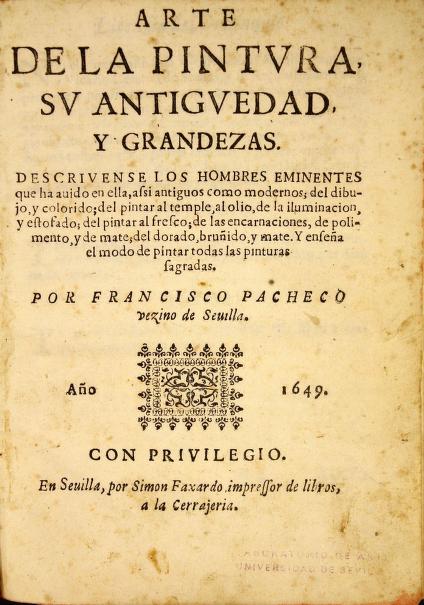
Frostispiece of Pacheco, El Arte de la pintura (1649), Seville, Simon Faxardo, impressor de libros, a la Cerrajeria
Within the Passion of Christ, Pacheco analyses the representation of the crowning of Jesus Christ. Following his study about the crown material, the author states that it was not made by thorns from sea reeds, as were made by artists in that time (not following appropriately the elements of that context). Also, in this passage, Pacheco brings a few arguments using wrong information (see Pacheco,1990, 640, n.18).
“bathing his hair, neck, and face with blood, and putting a hard cane in his right hand, although Lucca, to represent the living with these insignia that seemed King and mockery, to further mock him they knelt before him, saying Arer Rex Judeorum; and, spitting on his venerable face, they slapped him on the face and with the cane on his head, intending, with these scorns and blows, to torment him again and provoke the bystanders to laugh. St. Anselm speaks of these mockeries in this manner: it was the Lord dressed in royal purple; but, greater was the contempt that he received with her, a scepter was placed in his hand, but with it, his reverend head was wounded; he worshiped on his knees calling him king and they spit on his divine face and They cruelly tormented his cheeks. This is the painful painting of this step. Of the quality of the crown and its workmanship, we will say what seems most likely, because it will be painted correctly from now on. A modern scholar objects that it was not the crown of sea ??reeds, which is the most common of authors, with the authority of Cardinal Baronio, [….]”.
“bañando de sangre cabellos, cuello y rostro, y poniéndole en la mano derecha una caña dura, aunque hueca, para representar al vivo con estas insignias que cra Rey aparente y de burla, para más escarnecerlo se hincaban de rodillas ante Él, diciendo Arer Rex Judeorum; y, escupiendo su venerable rostro le daban en él bofetadas y con la caña sobre la cabeza, pretendiendo, con estos desprecios y golpes atormentarlo de nuevo y provocar a risa a los circunstantes. Destos escarnios habla San Anselmo en esta mancra: fue el Señor vestido de púrpura real; pero, mayor fue el menosprecio que recibió con ella, fuele puesto cetro en la mano, más con él fue herida su reverenda cabeza; adorába de rodillas llamándole rey y escupen en su divino rostro y cruelmente atormentaban sus mexillas. Esta es la pintura dolorosa deste paso. De la calidad de la corona y su hechura diremos lo que parece más probable, porque se pinte de aquí adelante acertadamente. Un docto moderno se opone a que no fue la corona de juncos marinos, que es lo más común de los autores, con la autoridad del Cardenal Baronio […]”.
Pacheco 1990, 640, n.18;



